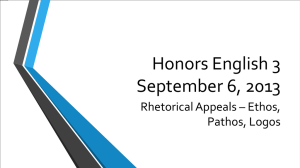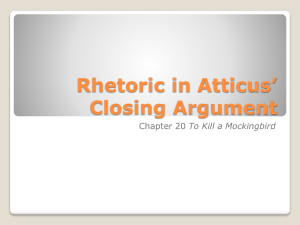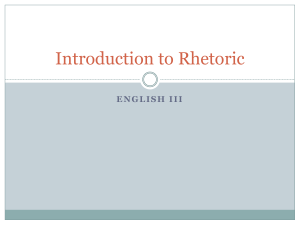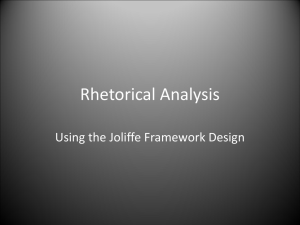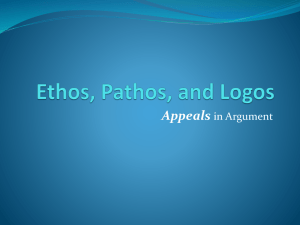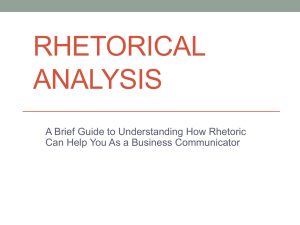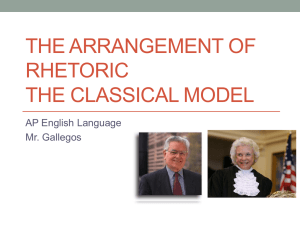File - Mrs. Stanford`s School of English
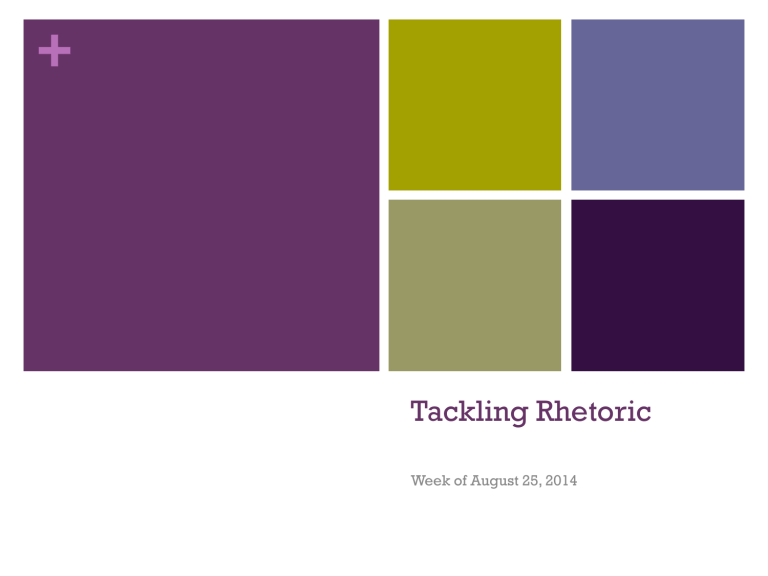
+
Tackling Rhetoric
Week of August 25, 2014
+
What is Rhetoric?
From Aristotle: The faculty of observing in any given case the available means of persuasion.
Rhetoric is a thoughtful, reflective activity leading to effective communication, including the rational exchange of opposing viewpoints.
In the time of Aristotle, and now in the 21 st century, those who understand and can use the available means to appeal to an audience of one or many find themselves in a position of strength.
Tools to resolve conflict
Persuade readers/listeners
Move others to take action
+
Where is Rhetoric?
You might use rhetoric to convince a friend that Iggy Azalea is worth listening to.
To explain to readers of your blog that The Walking Dead is extremely influential in the realms of zombie cinema.
To persuade your parents that they should buy you a car.
It’s important to note that rhetoric is not just about speeches.
Every essay, political cartoon, photograph, and advertisement is designed to convince you of something.
These texts are cultural products that can be read, meaning not just consumed and comprehended, but investigated.
We need to be able to read between the lines regardless of what we are reading or viewing.
+
What are these advertisements saying to you?
+
Now what about these?
+
The Rhetorical Situation
Lou Gehrig’s Farewell Speech
July 4, 1939
Transcript reading
Why is this an effective speech?
Occasion – the time and place the test was written/spoken
Context – the circumstances, atmosphere, attitudes and events surrounding the text
Purpose – the goal the speaker wants to achieve
http://youtu.be/626Dt9JdjQs
How does the video enhance the overall effect of the speech?
+
The Rhetorical Triangle
Represents the relationships within a rhetorical situation.
The Speaker/Author is the person or group that creates the text.
Don’t think of the speaker as solely a name, but consider a description of who the speaker is in context of the text.
Persona – the difference between who the speaker is in real life and the role they speaker plays when delivering the message.
+
Rhetorical Triangle
The audience is the listener, viewer, or reader of a text or performance.
There may be multiple audiences.
Speakers must ask what values their audience holds, and their general mood toward the subject matter.
The subject/text is the topic.
It should not be confused with the purpose, which is the goal the speaker wishes to achieve.
+
Practice…
Construct and analyze a rhetorical situation for writing a review of a movie, video game, or concert. Be very specific in your analysis: What is your subject? What is your purpose? Who is your audience? What is your relationship to the audience.
This is not an essay – just an analysis of the rhetorical situation.
+
SOAPSTone
In discussing the rhetorical situation surrounding a text, we’ve talked about some of the background that you should consider
(occasion, context, and purpose) and relationships that are more directly related to the text ( speaker, audience, subject).
One way to remember all of these things is through the acronym
SOAPSTone.
+
Dear Phyllis
Einstein is responsible for the theory of relativity, quantum mechanics, and other foundational concepts. He won the
Novel Prize in Physics in 1921. In 1936, he wrote the following letter to a sixth grade student, Phyllis Wright, in response to her questions: Do scientists pray? And if so, what do they pray for?
Analyze Einstein’s response using SOAPSTone.
+
George W. Bush, 9/11 Speech
Using SOAPSTone, analyze the rhetorical situation in G.W. Bush’s 9/11
Speech.
http://youtu.be/Ta8UBqsvwyE
+
Rhetorical Appeals
Rhetorical appeals are the attempts by a speaker to persuade an audience – or to put it another way, attempts to say things that an audience would find appealing.
Ethos
Pathos
Logos
+
Ethos
Speakers appeal to “ethos”
(Greek for Character) to demonstrate that they are trustworthy people who should be listened to when they discuss a given topic.
Speaker’s qualifications or authority play into this appeal as well.
http://tweakyourslides.wordpr
ess.com/2013/01/17/rhetoriclessons-from-ted/
+
Speech to Congress, Lyndon B.
Johnson, March 15, 1965
http://www.greatamericandoc
uments.com/speeches/lbjvoting-rights.html
How does LBJ bring ethos into the rhetorical situation?
The occasion was violence that had erupted the week prior in
Selma, Alabama, when
African-Americans preparing to march to Montgomery to protest voting-rights discrimination were attacked by police.
+
Quick thinking with a partner…
Think of a situation in which you are presenting your view on the same subject to two different audiences. For instance, you might be presenting your ideas on ways to stop bullying (1) to the school board, and (2) to a group of middle-schoolers. Discuss how you would establish ethos in each situation.
+
Logos
Speakers appeal to logos, or reason, by offering clear, rational ideas. Appealing to logos and using specific details, examples, facts, statistics, or expert testimony to support it.
Although Lou Gehrig’s speech may seem largely emotional, it is acutally cased on irrefutable logic. He starts with a thesis, “I am the luckiest man on the face of the earth” and supports it with 2 logical points
Love and kindness
His list of great people
+
Logos continued…
One way to appeal to logos is to acknowledge a
counterargument – that is, to anticipate objections or opposing views.
You’ll be vulnerable if you ignore ideas that run counter to your own.
In acknowledging a counterargument you agree (concede) that an opposing argument may be true or reasonable. But then you deny (refute) the validity of all or part of the argument.
This combination of concession and refutation actually strengthens your own argument; it appeals to logos by demonstrating that you understand a viewpoint other than your own, you’ve thought through other evidence, and you stand by your position.
+
Alice Walker – Slow Food Nation
+
From Slow Food Nation…
It's no wonder our national attention span is so short: We get hammered with the message that everything in our lives should be fast, cheap and easy -- especially food. So conditioned are we to believe that food should be almost free that even the rich, who pay a tinier fraction of their incomes for food than has ever been paid before in human history, grumble at the price of an organic peach -- a peach grown for flavor and picked, perfectly ripe, by a local farmer who is taking care of the land and paying his workers a fair wage! And yet, as the writer and farmer David Masumoto recently pointed out, pound for pound, peaches that good still cost less than Twinkies. When we claim that eating well is an elitist preoccupation, we create a smokescreen that obscures the fundamental role our food decisions have in shaping the world. The reason that eating well in this country costs more than eating poorly is that we have a set of agricultural policies that subsidize fast food and make fresh, wholesome foods, which receive no government support, seem expensive. Organic foods seem elitist only because industrial food is artificially cheap, with its real costs being charged to the public purse, the public health and the environment.
+
China’s Appetite for Coal
– George Will
Half of the 6 billion tons of coal burned globally each year is burned in China. A spokesman for the Sierra Club, which in recent years has helped to block construction of
139 proposed coal-fired plants in America, says, "This is undermining everything we've accomplished." America, say environmentalists, is exporting global warming. Can something really be exported if it supposedly affects the entire planet? Never mind.
America has partners in this crime against nature, if such it is. One Australian company proposes to build the Cowlitz facility; another has signed a $60 billion contract to supply
Chinese power plants with Australian coal.
The Times says ships - all burning hydrocarbons - hauled about 690 million tons of thermal coal this year, up from 385 million in 2001. China, which imported about 150 million tons this year, was a net exporter of coal until 2009, sending abroad its low-grade coal and importing higher-grade, low-sulfur coal from, for example, the Powder River
Basin of Wyoming and Montana. Because much of China's enormous coal reserves is inland, far from coastal factories, it is sometimes more economical to import American and Australian coal.
Writing in the Atlantic on China's appetite for coal and possible aptitude for using the old fuel in new, cleaner ways, James Fallows quotes a Chinese official saying that the country's transportation system is the only serious limit on how fast power companies increase their use of coal. One reason China is building light-rail systems is to get passenger traffic out of the way of coal trains.
Fallows reports that 15 years from now China expects that 350 million people will be living in cities that do not exist yet. This will require adding to China's electrical system a capacity almost as large as America's current capacity. The United States, China, Russia and India have 40 percent of the world's population and 60 percent of its coal.
+
China’s appetite for coal…
How does George Will appeal to logos in his article?
+
Pathos
Pathos is an appeal to emotions, values, desires, and hopes, on the one hand, or fears and prejudices on the other.
Although an argument that appeals exclusively to emotion is by definition weak – it’s generally propagandistic in purpose and more polemical than persuasive.
An effective speaker or writer understands the power of evoking an audience’s emotions by using such tools as figurative language, personal anecdotes and vivid images.
+
Richard Nixon – Checkers
One other thing I probably should tell you, because if I don’t they’ll probably be saying this about me too. We did get something, a gift, after the election. A man down in Texas hear Pat [Nixon’s wife] on the radio mention the fact that our two youngsters would like to have a dog. And believe it or not, the day before we left on this campaign trip we got a message from Union Station in Baltimore, saying they had a package for us. We went down to get it. You know what it was? It was a little cocker spaniel in a crate that he’d sent all the way from
Texas, black and white, spotted. And out little girl, Tricia, the 6-yearold, named it “Checkers.” And you know, the kids, like all kids, love the dog, and I just want to say this, right now, that regardless of what they say about it, we’re gonna keep it.
+
What are Nixon’s methods?
What emotions are engaged during
Nixon’s excerpt?
Do his words appeal more to logic or emotions?
+
Humor & Rhetoric
Humor works rhetorically by wrapping a challenge to our beliefs in something that makes us feel good – a joke – and thus makes us more receptive to the new idea.
Whether it is gentle tongue-incheek teasing or bitter irony, humor may help a writer make a point without seeming to preach to the audience or take himself too seriously.
+
Crackberry Congress..
-Ruth Marcus
+
The effect of Crackberry Congress
Letter structure
Connectivity
Humor builds her ethos
Lighthearted approach allows her to not sound prudish
She appeals to readers’ sense of humor as well as their community values:
Don’t we want out elected officials to forego “instantaneous communication” for more thoughtful deliberations when they are making decisions about the law of the land?
+
Combining Ethos, Logos & Pathos
Most authors don’t rely on a just a single type of appeal to persuade their audience; they combine these appeals to create an effective argument. And the appeals themselves are inextricably bound together: if you lay out your argument logically, that will help build your ethos.
Take a look at Toni Morrison, the only African American woman to win the Nobel Prize for Literature, who wrote the following letter to then senator Barack Obama endorsing him as the Democratic candidate for president in 2008. The letter was published in the New York Times.
+
Morrison’s letter to Obama
Letter
Who is Morrison’s audience for this letter?
Does she need to establish ethos based on her audience?
How does she develop a logical argument without figures or expert sources?
How does she appeal to pathos?
+
Activity – Think, Pair, Share
Choose one of the following rhetorical situations, and discuss how you would establish your ethos and appeal to logos and pathos.
1.
2.
3.
4.
You are trying to persuade your skeptical parents that a “gap year” – taking a year off between high school and college will be beneficial.
You have been asked to make a presentation to your school’s principal and food-service staff to propose healthier food choices in the cafeteria at a time when the overall school budget in constrained.
You are making the case for the purchase of a specific model and make of car that will best fit your family’s needs and resources.
You are the student representative chosen to go before a group of local businesspeople to ask them to provide financial support for a proposed school trip.
+
Fiction & Poetry
Imaginative literature (fictional pieces of literature) often have a rhetorical purpose, even if it’s not immediately obvious. The most direct use of rhetoric in imaginiative literature is through a speech by a character or a persuasive bit of dialogue between characters.
Consider the soliloquies in Shakespeare’s plays, or Atticus
Finch’s close argument in To Kill a Mockingbird.
These examples of literary rhetoric usually have 2 speakers, the author and the character. It’s important to keep in mind the concept of persona and remember that these two speakers are not necessarily the same and might not have the same purpose.
+
SOAPSTone
Using SOAPSTone, analyze the excerpt from The Killer
Angels by Michael
Shaara.
+
When I heard the learn’d astronomer – Walt Whitman
WHEN I heard the learn’d astronomer;
When the proofs, the figures, were ranged in columns before me;
When I was shown the charts and the diagrams, to add, divide, and measure them;
When I, sitting, heard the astronomer, where he lectured with much applause in the lecture-room,
How soon, unaccountable, I became tired and sick;
Till rising and gliding out, I wander’d off by myself,
In the mystical moist night-air, and from time to time,
Look’d up in perfect silence at the stars.
+
Whitman
The poem seems simple enough, but who is the speaker?
Is it Whitman? How do you know for sure?
The poem’s single periodic sentence presents the thoughts of a person who attends a lecture, becomes bored, and goes outside to soak in the majesty of nature.
What rhetorical purpose does this poem serve?
Whitman’s attempt to not only express his view but also to convince us to share in it?
+
Activity – I sit and sew
In 1920, the African American poet Alice Dunbar-Nelson wrote “I Sit and Sew,” a dramatic monologue protesting the limitations of her assigned role during a time of war. Analyze the poem rhetorically, paying close attention to the argument the speaker develops.
I sit and sew
+
Rhetorical Analysis of Visual Texts
+
Visual Texts
Many visual tests are fullfledged arguments. Although they may not be written in paragraphs or have a traditional thesis, they are occasioned by specific circumstances, they have a purpose (whether it is to comment on current events or simply to urge you to buy something), and they make a claim and support it with appeals to authority, emotion and reason.
+
Consider this…
Tom Toles drew this cartoon after the death of civil rights icon Rosa Parks in 2005. Parks was the woman who refused to give up her seat on the bus in
Montgomery, Alabama. Her act became a symbol for the struggle for racial equality in the U.S.
What is the occasion? Who is the speaker? Who is the audience? What is his purpose?
+
His purpose and meaning…
Toles’s purpose is to remember Parks as an ordinary citizen whose courage and determination brought extraordinary results.
The subject is the legacy of
Rosa Parks, a well-known person loved by many.
The caption appeals to both pathos and logos. Its emotional appeal is its acknowledgement that, of course, heaven would have been waiting for this good woman.
+
Steve Jobs – Visual Rhetoric
Stanford Commencement
Speech
Transcript first
http://youtu.be/UF8uR6Z6KLc
What are the differences between the written version and watching the actual video and auditory version?
Which one is more effective?
Why?
+
Sojourner Truth – Ain’t I a Woman?
Transcript
http://youtu.be/vXjN2TK1qoQ
Video versus text – again, which is more effective and why?
+
Determining Effective and
Ineffective Rhetoric
Is this ad from PETA, an animal rights group effective? What message(s) is it sending?
+
The Breakdown…
A positive reading would see the image of an overweight child about to bite into a burger as an attention getter.
Most people would not have thought of this connection.
Shock value
Childhood obesity
Replacing burgers with veggies is a healthier alternative – one that no one would find questionable.
A negative reading would see that allowing a child to eat a hamburger is the same as committing child abuse – which is a serious allegation.
Hyperbole?
Ad loses it’s purpose because of the exaggeration.
No one would argue with “fight the fat” – but to link the consumption of any kind of meat with a heinous act of child abuse might not seem logical to every viewer – which undermines the ad’s effectiveness.
+
The Verdict…
+
Let’s look at another piece…
If the Japanese Can’t Build a Safe
Reactor, Who Can?
Does Applebaum miss her mark?
Does she use a worst-case scenario to make her case?
Do her references to 9/11 and
WW2 make nuclear power seem alarming, or do they just make her sound like an alarmist?
Are her fears justified?
+
Activity
Take a look at the rhetorical analysis of the effectiveness of Anne Applebaum’s argument written by an AP student, Tamar
Demby. How does she develop her position? Do you agree or disagree?
Explain. How might she improve her essay?
+
Effective or Ineffective? Why?
+
Effective or Ineffective? Why?
+
Fallacies of Argument
+
Scare Tactics
Politicians, advertisers and public figures sometimes peddle their ideas by scaring people and exaggerating possible dangers well beyond their statistical likelihood. Such ploys work because it’s easier to imagine something terrible happening than to appreciate its rarity.
Scare tactics can also be used to stampede legitimate fears into panic or prejudice.
People who genuinely fear losing their jobs can be persuaded to fear that immigrants might work for less money.
Such tactics have the effect of closing off thinking because people who are scared often act irrationally. Even wellintended fear campaigns – like those directed against smoking, drugs, etc – can misfire their warnings because they are too shrill. People just stop listening.
+
Scare tactics…
+
Either – Or Choices
One way to simplify arguments and give them power is to reduce complicated issues to just two options, one obviously preferable to the other.
Either – Or choices can be well-intentioned strategies to get something accomplished. Parents use them all the time. But they become fallacious arguments when they reduce complicated issues to excessively simple terms or when they’re designed to obscure legitimate alternatives.
I.E.: To suggest that renewable power sources such as wind and solar represent the only long-term solution to our energy needs may have rhetorical power, but the choice is too easy and uncomplicated. Energy shortages can be fixed in any number of ways, including wind and solar power.
+
Either Or
+
Slippery Slope
Slippery slope portrays today’s tiny misstep as tomorrow’s slide into disaster.
Some arguments that aim at preventing dire consequences do not take the slippery slope approach (for example the parent who corrects a child for misbehavior now is acting sensibly to prevent more serious problems as the child grows older).
A Slippery Slope argument becomes wrongheaded when a writer exaggerates the likely consequences of an action, usually to frighten readers. As a result slippery slope arguments can also fall under the scare tactics category.
+
Slippery Slope
+
Sentimental Appeals
Use tender emotions excessively to distract readers from facts.
High personal and individual – focus attention on heartwarming or heartwrenching situations that make readers feel guilty if they challenge the ideas.
Emotions become an impediment to civil discourse when they keep people from thinking clearly.
I.E.: A news show can document the day-to-day sacrifices of parents who are trying to meet their mortgage payments and keep their kids in college in a tough economy. Their on screen struggle can represent the spirit of an entire class of people threatened by bankers. While such individual stories stir genuine emotions, they seldom give the complete picture of a complex social or economical issue.
+
Sentimental Appeals (Appeal to
Emotion)
+
Bandwagon Appeals
Urge people to follow the same path everyone else is taking.
Rather than think independently about where to go, it’s often easier to get on board the bandwagon with everyone else.
Children use this on their parents all the time.
Not all bandwagon approaches are transparent. Recent decades have seen bandwagon issues including the war on drugs, the nuclear freeze movement, the campaign against drunk driving, campaign finance reform, illegal immigration, the defense of marriage, and bailouts for banks and businesses. These issues are all too complex to permit the suspension of judgment that bandwagon tactics require.
+
Bandwagon
+
Your culminating project…
Rhetoric at work in our daily lives.

